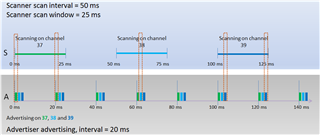Hello,
We are currently working on a project where up to 40 battery powered devices need to talk with one router/coordinator. Each device features a proximity sensor and an LED. They are mounted in an area of around 25 m in length and 2 m in width. However it is difficult to change their battery, therefore long battery life is crucial. There is one Central Device, which collects all the information from the sensors and decides, which LEDs need to light up. The devices need to track an object which will always remain on device no. 1 for a few seconds and then starts moving. So they only need to transmit data if their sensor is triggered (1 Byte of data) but they need to be able to receive data at all time in order to make the LED light up (large latency of 500ms or so is fine).
I hope you can understand the background of the application.
My question is, how such a network could be accoplished? Zigbee, Thread and Bluetooth Mesh seem to use a lot of RAM as the number of End Devices connected to one Router (or however they are called) goes up and most of the time a limit of 20 End Devices is suggested, but maybe I have missed something. Developing a proprietary protocol would probably provide the best result, however out Software Engineers are very busy at the moment and we've not worked with RF technology yet. So I'm favoring the easiest solution. My idea was to use a Star Topology and have the End Devices sleep periodically in order so save current. Once their sensor is triggered (which doen't happen often) they change their behaviour to an alway-on state, so do the closest neigbours (identified by their specific adress), so the object can be precisely tracked.
In terms of hardware we have been looking at the nRF52840, but this is not determined yet. Could it be an option to use two chips on the PCB of the central device and have each talk to 20 end devices? How far would they have to be apart from each other so they don't interfere with each other to much?
If you have any ideas or suggestions I'd highly appreciate your help!
Best regards
Adrian



